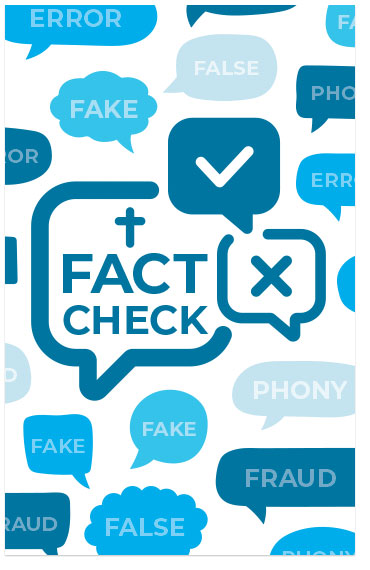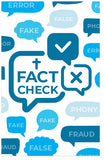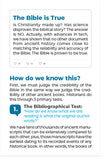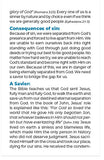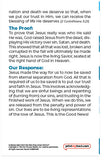Fact Check
Special-Order Folded Tract
 NOTE: This item is custom-printed to order (click for more details).
NOTE: This item is custom-printed to order (click for more details).
This tract is from our print-on-demand library, and is not kept in stock. Select the options below, and we will custom-print a batch just for you. Because this item is custom-printed, you can add your custom imprint to the back page at no extra cost.
- Estimated shipping date: Monday, January 12 (Click for more details)
- SKU:
- Discounts: Discount coupons do not apply to this item
- Format: Folded Tract
- Size: 3.5 inches x 5.5 inches
- Pages: 6
- Imprinting: Available with 4 lines of custom text
- Version: NKJV
- Returns: Because this item is custom-printed to order, it cannot be returned.
Show all item details
The full text of this tract is shown below in the NKJV version. (Do you want to print this tract in a different version than the one listed? Contact us and let us know what you're looking for—we may be able to create the alternate version for you at no charge.)
The Bible is True
Is Christianity made up? Has science disproven the biblical story? The answer is NO. Actually, with advances in tech, we have shown that no other document from ancient history comes close to matching the reliability and accuracy of the Bible. The Bible is proven to be true.
How do we know this?
First, we must judge the credibility of the Bible in the same way we judge the credibility of other ancient books. Historians do this through 3 primary tests.
1. The Bibliographical Test:
“How do we know what we are reading is what the original author wrote?”
We have tens of thousands of ancient manuscripts that can be extensively compared to each other; plus, those manuscripts have the earliest dating to its recorded events of any historical book. In other words, the books of the New Testament were written very soon after the events they describe, leaving no room for legend or myths to creep in.
2. The Internal Evidence Test:
“Does the book contradict itself?”
With 40 different authors and three quarters of a million words written in three different languages over nearly 16 centuries, absolutely nothing consequential is contradicted in the Bible. The only variations found are in spelling, numerical differences, sentence word order changes, etc.
3. The External Evidence Test:
“Does evidence outside the Bible corroborate the text?”
Time and again, the historicity of the Bible has been confirmed by biology, geology, and astronomy: not one piece of archeological evidence has been found that contradicts or disproves the Bible. Archaeology has proven the Bible true through evidence such as the Dead Sea Scrolls, the basalt stone containing the “House of David” inscription, a 7th century BC amulet scroll bearing the name of God, and a stone bearing the name and title of Pontius Pilate, the Judean governor who ordered the execution of Jesus Christ.
So basically, everything that is written in the Bible is the same as was originally written over 3000 years ago and none of it contradicts itself or has been found to be untrue but instead has been proven by archeology to be factual.
What does the Bible teach?
So now that we know the Bible is a reliable source of information, what does it teach?
The “gospel,” or good news of the Bible goes like this:
The meaning of life:
The main purpose of our lives is to have a relationship with and to glorify God. And this is what life looked like in the Garden of Eden—people lived in harmony with and in God’s presence.
Introduction of sin:
But because of our rebellious nature as humans, we broke the bond between man and God when Adam and Eve disobeyed God and introduced sin into the world. Since then, the Bible says “all have sinned and fall short of the glory of God” (Romans 3:23). Every one of us is a sinner by nature and by choice even if we think we are generally good people (Ephesians 2:1-3).
Consequences of sin:
Because of sin, we were separated from God’s presence and forced to live apart from Him. We are unable to earn ourselves back into right standing with God through just doing good deeds or trying our best to be good people. No matter how hard we try, we are unable to reach God’s standard and become right with Him on our own. Because of this, we are in danger of being eternally separated from God. We need a savior to bridge the gap for us.
A Savior:
The Bible teaches us that God sent Jesus, fully man and fully God, to walk the earth and save us from our destined eternal separation from God. In the book of John, Jesus’ role is explained like this: “For God so loved the world that He gave His only begotten Son, that whoever believes in Him should not perish but have everlasting life” (John 3:16). Jesus lived on earth a sinless and blameless life, which made Him the only person in history who did not deserve judgment. Jesus sacrificed Himself on the cross and took our place, dying for our sins. He received the condemnation and death we deserve so that, when we put our trust in Him, we can receive the blessing of life He deserves (2 Corinthians 5:21).
The Proof:
To prove that Jesus really was who He said He was, God raised Jesus from the dead, displaying His victory over sin, Satan, and death. This showed that all that was lost, broken and corrupted in the fall will ultimately be made right. Jesus is now the living Savior, seated at the right hand of God in Heaven.
Our Response:
Jesus made the way for us to now be saved from eternal separation from God. All that is required of us to be saved is to put our trust and faith in Jesus. This involves acknowledging that we are sinful beings and repenting of (turning from) our sins, and trusting in the finished work of Jesus. When we do this, we are released from the penalty and power of sin. Our lives are to be living representations of the love of Jesus. This is the Good News!

